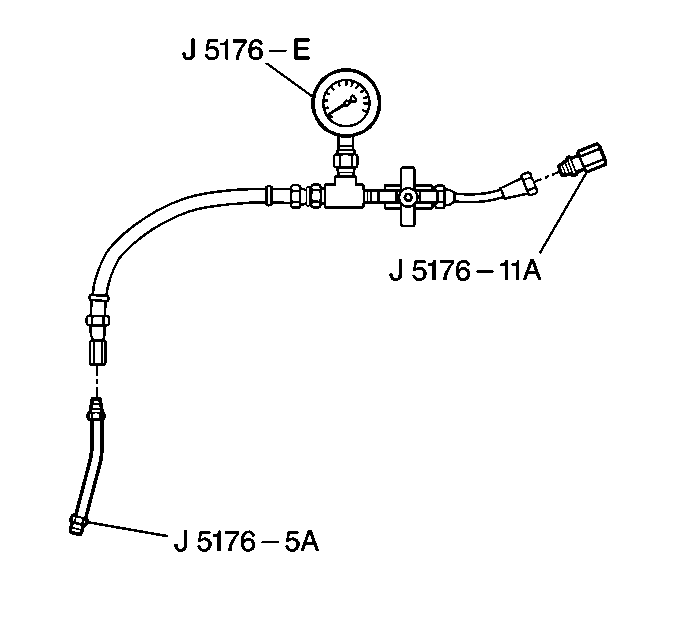Tools Required
| • | J 5176-E Power
Steering Pressure Tester 0-2000 PSI |
| • | J 5176-11A Power Steering Pressure Tester Adapter |
| • | J 5176-5A Power Steering Pressure Tester Adapter |
Perform the following procedure to the determine the cause if a hydraulic
or a mechanical malfunction of the pump or the power steering gear is suspected:
- Disconnect the power steering pump pressure (discharge) hose from
the pump. Use a small container to catch any fluid which might leak.

Caution: After connecting the J 5176, ensure the hoses do
not contact the serpentine belt or pulleys. Personal injury may result.
- Connect the J 5176-5A Power Steering Pressure Tester Adapter
to the pump.
- Use the J 5176-11A Power Steering Pressure Tester Adapter
to connect the pressure tester to the power steering pressure hose.
- Open the valve on the J 5176-E
- Bleed the power steering system. Refer to
Power Steering System Bleeding
.
- Start the engine.
- Allow the engine to reach normal operating temperature.
- The pressure should be no more than 1 034 kPa (150 psi)
with the engine at idle and with the valve open on the J 5176-E
- Perform the following steps if the pressure is more than 1 034 kPa
(150 psi):
| • | Check the hoses for restrictions. |
| • | Check the hoses for kinks. |
| • | Check the pipes for restrictions. |
| • | Check the pipes for kinks. |
| • | Check the valve on the steering gear inlet hose fitting for proper
operation. |
| • | Check the valve on the steering gear inlet hose fitting restriction. |
| • | The steering gear is internally restricted if O.K. |
Notice: Do not leave the valve fully closed for more than 5 seconds, or the
pump could be damaged internally.
- Close the valve on the J 5176-E
three times.
- Record the pressure reading each time. Each reading should show
at least 11 032 kPa (1,600 psi). The three readings should
be within 345 kPa (50 psi) of each other.
- The pump is functioning properly if the pressure readings are
high enough and are within 345 kPa (50 psi) of each other.
- Replace the pump if the pressure readings are less than 11 032 kPa
(1,600 psi).
- Leave the valve open if the pump checks to specification.
Notice: Do not hold the steering wheel in the full turn position
longer than 5 seconds, as damage to the steering pump may result.
- Have an assistant turn the steering wheel to both stops.
- Record the highest pressures.
- Compare the readings with the highest pump pressure recorded earlier.
- The steering gear is leaking internally and must be repaired if
the pressure at both stops is not the same as the maximum pressure.
- Turn off the engine.
- Remove the J 5176-E
Notice: Use the correct fastener in the correct location. Replacement fasteners
must be the correct part number for that application. Fasteners requiring
replacement or fasteners requiring the use of thread locking compound or sealant
are identified in the service procedure. Do not use paints, lubricants, or
corrosion inhibitors on fasteners or fastener joint surfaces unless specified.
These coatings affect fastener torque and joint clamping force and may damage
the fastener. Use the correct tightening sequence and specifications when
installing fasteners in order to avoid damage to parts and systems.
- Connect the power
steering pump pressure (discharge) hose to the pump.
Tighten
Tighten the power steering pump pressure (discharge) hose fitting to
28 N·m (21 lb ft).
- Bleed the power steering system. Refer to
Power Steering System Bleeding
.

